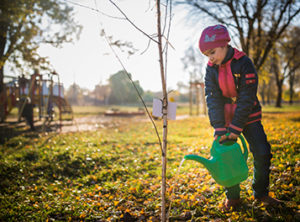Wondering how often you should water your trees? The answer can depend on many factors. Here’s the scoop.

Whenever we get a dry summer, we often get asked about drought prevention, specifically when it comes to watering your trees. Although there are general guidelines you can follow, it should be noted that there are many factors that dictate how often to water. Here are 10 factors that can impact your watering schedule.
Type of soil
Understanding your soil texture can help determine how often you should water your tree. The three basic types of soils are sand, silt and clay, and most soils are a mixture of these.
Drainage
Knowing where your property drains can help solve this dilemma. Low spots on properties can hold water longer. Some new subdivisions have drainage ditches that run along multiple back yards that move the water away from several homes. Downspouts can direct water to unwanted areas. A good indicator of where water flows on your property is to monitor your yard during a heavy rainfall and watch for pooling and runoff.
Tree species
Different species like different growing conditions and tolerate varying degrees of drought. ISA Certified Arborists can help to select the correct species for your property.
Weather
The amount of precipitation should change the frequency and amount of watering. If sufficient rainfall occurs, it is okay to skip watering that day or week. This may seem obvious, but you still see irrigation systems running during a rainstorm.
Location/sun
The more exposed a tree is, the faster the soil dries out. A tree in direct sun should be watered more than a tree in the shade.
Irrigation
Although your irrigation system comes on 3 times a week, this is not sufficient for newly planted trees but is usually sufficient for established trees.
Hardscaping
Interlock patios, pools, roads, sidewalks, decks and houses all more water away or towards a tree. If installing a new hardscape, make sure to discuss where the water will go. If installing a new tree, make sure to figure out how the water moves on your existing hardscapes.
Soil compaction
A lot of urban soils are compacted, especially in high traffic areas. Compact soils mimic hardscapes and absorb significantly less water.
Mature trees
Mature trees are the forgotten plants of the landscape. Even though most large trees have massive root systems that are able to draw water from a large area, in times of drought, established trees will appreciate a deep soak. Mature trees require manual watering much less frequently than new trees. Watch for wilting, yellowing, or scorching of leaves.
Baby trees
Newly planted trees do not have established root systems and will require much more consistency and care when it comes to watering. Whether the tree was in a pot, bare root or ball & burlap, the root system of the tree has been severely reduced or restricted limiting the water uptake.
Making sure that you have selected the right tree for the right locations is step one. Many tree species will tolerate a range of soil moistures, but it is important to know before purchasing.
A quality installation by your friendly neighbourhood arborist should include the initial watering, but afterward, it becomes the property owner’s responsibility to keep their baby trees properly hydrated. The first few days or weeks are crucial and can make or break a successful planting.
If you’re concerned about the state of your trees and large shrubs and you’re looking for some expert advice, contact us for a consultation!